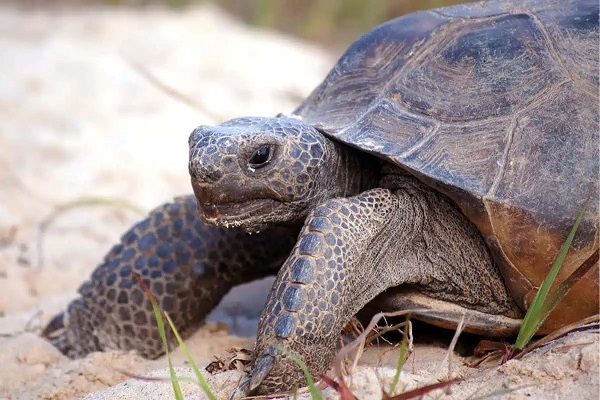
Tortoises are land-dwelling, unlike other aquatic turtles, which have high-domed shells, thick legs, and no webbed feet. Instead of escaping into the water, they rely on burrowing and their tough shells for protection.
There are 6 types of tortoises in North America, each of which dwells in a different environment best suited for them.
All tortoises belong to the turtle family, but not all turtles are tortoises. The key differences come down to habitat and physical adaptations.
This article covers the species of tortoises native to North America, from the arid deserts of the Southwest to the coastal plains of the Southeast. Now, let’s take a look at the types of tortoises found in North America.
6 Types of North American Tortoises;
1. Desert Tortoise
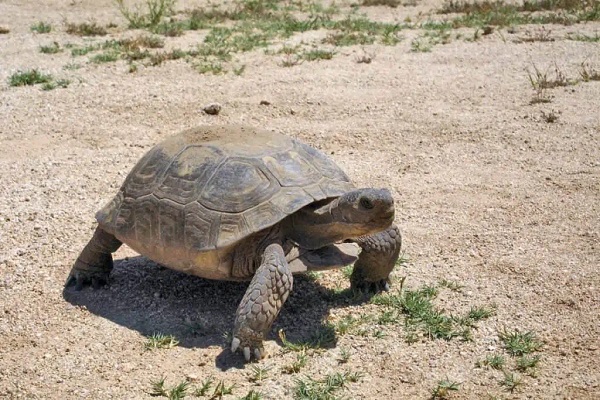
- Scientific name: Gopherus agassizii
- Adult length: 9–15 inches (23–38 cm)
- Adult weight: 8–15 pounds (3.6–6.8 kg)
The desert tortoise is one of the most recognizable tortoise species in North America, known for its ability to survive in harsh desert conditions. It spends most of its life in underground burrows, emerging primarily during the cooler months or after rain. Despite their slow speed, they are highly resilient and capable of surviving without direct water sources for months by absorbing moisture from food.
Desert tortoises are found in the Mojave and Sonoran Deserts, with populations spread across California, Nevada, Arizona, and Utah. They prefer open, dry landscapes with sparse vegetation, often settling in rocky hillsides, sandy flats, and washes where they can dig deep burrows for shelter.
These tortoises primarily consume wildflowers, grasses, and cacti, with prickly pear pads being a significant water source. Their digestive system is adapted to extract as much moisture as possible from their diet, allowing them to go long periods without drinking standing water.
The desert tortoise has a high-domed shell with a brownish or greyish colour that helps it blend into its surroundings. Its thick, scaly front legs are specially adapted for digging, while its hind legs are strong and rounded, allowing it to push through loose soil when constructing burrows.
The desert tortoise is classified as threatened, with habitat destruction, vehicle collisions, and respiratory diseases being major threats. Conservation programs focus on habitat protection, reducing human interference, and raising awareness about the risks of moving tortoises from their natural environment.
2. Texas Tortoise
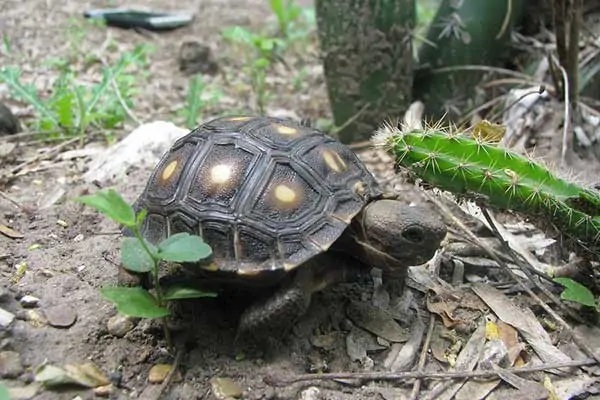
- Scientific name: Gopherus berlandieri
- Adult length: 6–9 inches (15–23 cm)
- Adult weight: 1–2 pounds (0.5–0.9 kg)
The Texas tortoise is the smallest native tortoise in the United States, known for its slow movements and preference for dense brush habitats. Unlike its desert relatives, it thrives in semi-arid regions with more vegetation. It is less likely to dig deep burrows, instead sheltering under thick shrubs or in shallow scrapes in the soil.
This species is found in the thorn scrub and grasslands of southern Texas and northeastern Mexico. It prefers sandy or loose soils with plenty of plant cover, often seeking shelter under prickly pear cacti and mesquite trees to escape the heat.
Texas tortoises have a varied herbivorous diet, feeding on grasses, wildflowers, and succulents. They have a strong preference for prickly pear cactus, eating both the pads and the fruit, which provides much of their water intake. They are known to eat in short bursts throughout the day, unlike desert tortoises that often feed heavily after rain.
This tortoise has a lower, more oval-shaped shell compared to the high-domed desert tortoise. Its shell is yellowish-brown with rough, deeply textured scutes that help it blend into dry, grassy environments. Its limbs are shorter and less heavily built, allowing it to move through denser vegetation more easily.
The Texas tortoise is protected by law in both the United States and Mexico due to habitat loss and illegal collection for the pet trade. While it is not considered endangered, its population has been declining due to land development and road mortality.
3. Gopher Tortoise
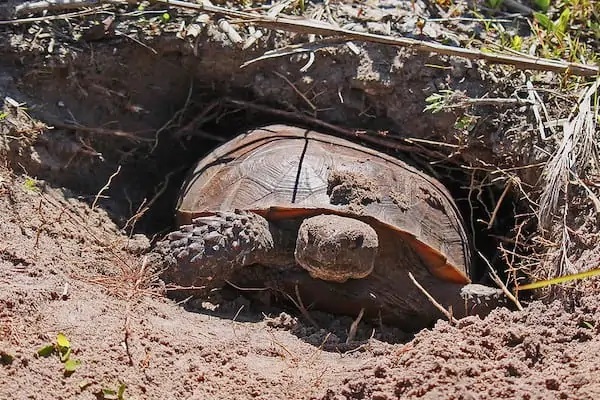
- Scientific name: Gopherus polyphemus
- Adult length: 9–15 inches (23–38 cm)
- Adult weight: 8–15 pounds (3.6–6.8 kg)
The gopher tortoise is a keystone species found in the southeastern United States, known for digging deep burrows that provide shelter for hundreds of other animals. These tortoises are highly terrestrial and prefer open, dry habitats with well-drained, sandy soil. They are active year-round but are most commonly seen in the spring and summer.
Gopher tortoises are found in Florida, Georgia, Alabama, Mississippi, Louisiana, and South Carolina. They inhabit pine flatwoods, scrublands, coastal dunes, and grasslands where they can easily dig their burrows. These burrows, which can extend up to 40 feet long and 10 feet deep, provide shelter not only for the tortoise but for many other species, including snakes, amphibians, and small mammals.
Gopher tortoises are herbivores, feeding primarily on grasses, legumes, wildflowers, and low-growing vegetation. They occasionally eat fruits and mushrooms, but their diet consists mostly of fibrous plant material. They play a role in seed dispersal, helping to maintain plant diversity in their habitat.
This species has a dark brown to greyish-black shell with a flattened top and a lighter-coloured plastron. Its front legs are thick and covered in protective scales, designed for powerful digging. Compared to other tortoises, it has a relatively large head with a sharp, beak-like mouth adapted for clipping tough vegetation.
The gopher tortoise is considered vulnerable due to habitat destruction, road mortality, and human interference. Since they rely on sandy, well-drained soils, development projects and agriculture have significantly impacted their populations. Conservation programs focus on protecting their burrows and preserving pine forest ecosystems.
4. Sonoran Desert Tortoise
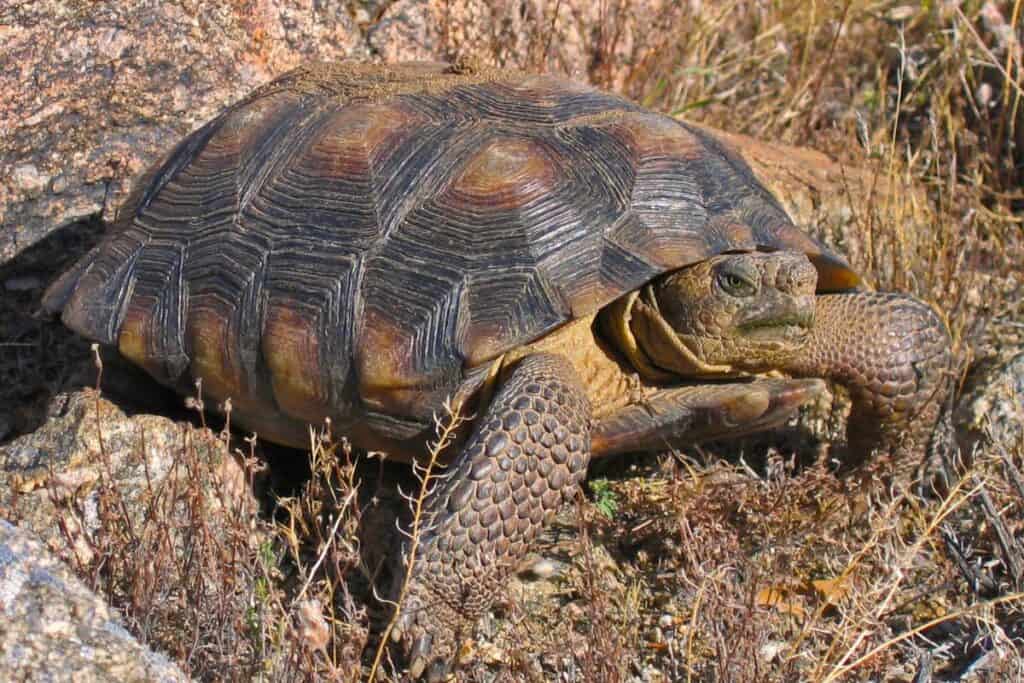
- Scientific name: Gopherus morafkai
- Adult length: 8–14 inches (20–36 cm)
- Adult weight: 8–12 pounds (3.6–5.4 kg)
The Sonoran desert tortoise is closely related to the desert tortoise but is now recognized as a separate species. It is found in the rocky, mountainous regions of the Sonoran Desert, where it relies on boulders and crevices for shelter rather than digging deep burrows like its Mojave counterpart. This species is highly adapted to extreme heat and can go for long periods without drinking water.
This tortoise is native to southern Arizona and northern Mexico, particularly in the Sonoran Desert. Unlike the Mojave desert tortoise, which prefers sandy terrain, the Sonoran desert tortoise is often found in rocky foothills, canyons, and mountainous areas where it uses rock shelters to escape the heat.
Its diet consists of a variety of desert plants, including cacti, grasses, and wildflowers. During monsoon season, it takes advantage of the fresh vegetation that grows after the rains. It also consumes dried vegetation when food is scarce, extracting moisture from its food to stay hydrated.
Sonoran desert tortoises have a slightly flatter shell compared to Mojave desert tortoises, with a darker, more rugged appearance. Their legs are strong and covered in thick scales, helping them navigate rocky terrain. Unlike their Mojave counterparts, they are less likely to dig extensive burrows and instead seek shelter under large rocks or inside caves.
Though not as threatened as the Mojave desert tortoise, the Sonoran desert tortoise faces risks from habitat destruction, climate change, and human expansion. Efforts to monitor populations and protect desert habitats have helped maintain stable numbers, but ongoing threats remain.
5. Bolson Tortoise
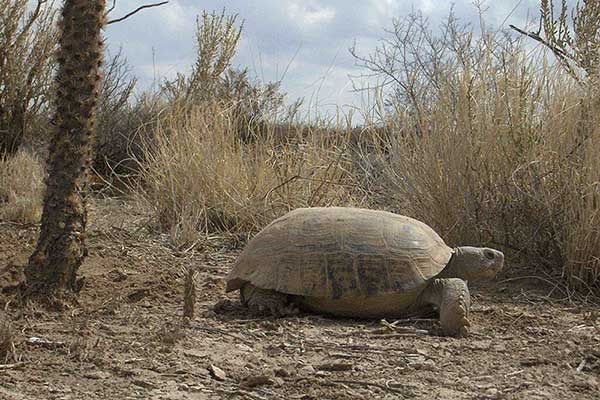
- Scientific name: Gopherus flavomarginatus
- Adult length: 14–18 inches (36–46 cm)
- Adult weight: 15–25 pounds (6.8–11.3 kg)
The Bolson tortoise is the largest of the North American tortoises and is native to northern Mexico, with some populations near the U.S.-Mexico border. Unlike the desert tortoises of the southwestern U.S., it prefers more temperate, grassland habitats. This species is highly reclusive and was once thought to be extinct in the wild due to habitat loss and human activities.
The Bolson tortoise inhabits the Chihuahuan Desert grasslands in northern Mexico, particularly in areas with loose, sandy soil where it can dig burrows. It is less adapted to extreme desert conditions than its smaller relatives and relies on the cooler temperatures of grasslands for survival.
This tortoise primarily feeds on grasses, forbs, and succulent plants, often grazing for long periods during cooler parts of the day. It has a slow metabolism and can survive on limited resources for extended periods.
The Bolson tortoise has a large, high-domed shell with a dark brown or grayish color. Its scutes are well-defined, giving it a segmented, rugged look. Its legs are thick and sturdy, built for digging deep burrows that protect from predators and temperature extremes.
The Bolson tortoise is listed as endangered due to habitat destruction and illegal collection. Efforts to reintroduce populations into protected areas in the southwestern U.S. have been ongoing, with conservationists monitoring its recovery. Climate change and land conversion for agriculture remain significant threats to its survival.
6. Agassiz’s Desert Tortoise
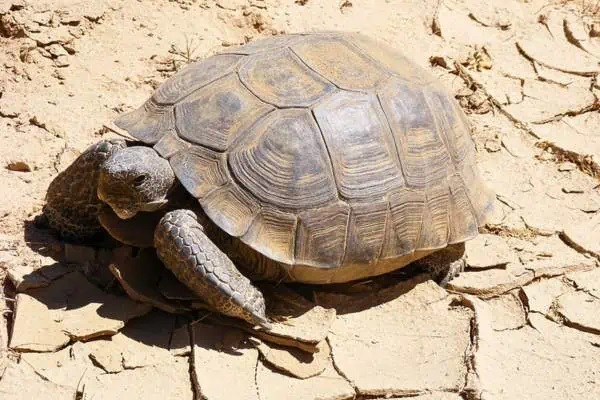
- Scientific name: Gopherus agassizii
- Adult length: 9–15 inches (23–38 cm)
- Adult weight: 8–15 pounds (3.6–6.8 kg)
Agassiz’s desert tortoise was long considered the same species as the Sonoran desert tortoise, but genetic studies have confirmed it as a separate species. It primarily inhabits the Mojave Desert, where it faces some of the most extreme temperature conditions of any North American tortoise. This species is well adapted to hot, arid environments and can survive long periods without drinking water.
Agassiz’s desert tortoise is found in the Mojave Desert, including parts of California, Nevada, Utah, and Arizona. It prefers sandy flats, rocky washes, and low shrubland where it can dig extensive burrows. These burrows provide critical shelter from extreme heat and cold.
Like other desert tortoises, its diet consists primarily of grasses, wildflowers, and cacti. It relies on seasonal rains to trigger plant growth and is most active during the cooler months of spring and fall.
Agassiz’s desert tortoise has a high-domed, brownish shell with thick, scaly legs that allow it to traverse rough desert terrain. It has a slightly lighter colouration than its Sonoran counterpart, helping it blend into the sandy environment.
Agassiz’s desert tortoise is listed as threatened due to habitat destruction, vehicle collisions, and disease. Conservation efforts focus on protecting critical desert habitats and reducing human interactions that may negatively impact wild populations.



